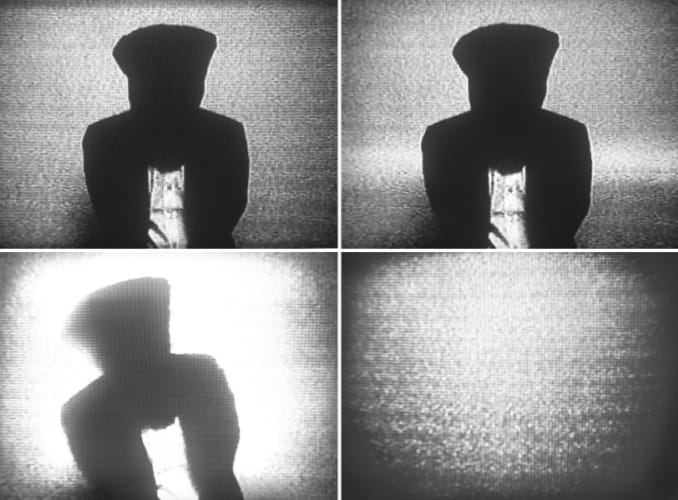Flickering Light, 1983 - 1984
Hong Kong 2016

Chi-Wen Gallery
Video/Film
Single-channel Video, Black and White, Silent, 41 seconds 25 frames, Continuous Loop
0Artist Statement
The filming of Flickering Light in late 1983 or early 1984 was motivated by my impressions of two experiences. (1) The first was my disappointment when watching the guerrilla-style action-art piece Dysfunction No. 3 that I made in 1983. We performed wearing hoods in order to walk blindly down a public street, and while our actions and the disturbed expressions of pedestrians are visible in the film, my internal experience as I performed cannot be detected. (2) The other experience was Taiwan's first armed bank robbery, which happened in 1982. Hoping for a break in the case, Taiwan's three government controlled television stations continually broadcast the bank's blurry surveillance footage of Li Shih-ke wearing a hat, wig, and surgical mask and carrying a gun while stepping over the teller line. Watching the television, I wondered how it was that Li used a disguise and transgressed the symbolic line of the law to take back his expropriated right to author his own fate. (3) Also, the gun he carried, which he obtained by murdering a police officer, makes me think of the chronophotographic gun, an instrument that appeared briefly in the history of cinematography. (4)
As if somehow interconnected—impossible to observe inner perceptions of someone being filmed; Li Shih-ke's transgressive act in disguise; links among bank surveillance, governments, capitalism and the military-industrial complex; (5) the many implications of guns; and the inexplicable images arising from the flickering light of a television's scanning lines that seemed to transcend electronic technology and its function when a blurry bank video was repeatedly broadcast—all these things made me want to create Flickering Light in a style that imitates surveillance footage.
Several years later, I became increasingly confused about my motivations for wanting to make art in the first place, and lost track of the videotape after I had destroyed much of my earlier work. Sometime around 2002, my brother converted a large quantity of video tapes to DV format at a video production studio. Among the many government-produced documentaries we had pirated, he had discovered a fragment of Flickering Light but never mentioned that he converted it along with the others until recently in 2015. I used two VCRs to edit the video and a portion was erased, so the original film was a little longer than what exists today. I chose the title after the film's rediscovery.
After being forgotten for so long, the film feels strange in a way that is difficult to pin down. I think this feeling may come from the film's fictional convict who is knocked down when struck by light (today this might suggest the cruel treatment and murder of prisoners, or perhaps ubiquitous surveillance cameras), but even more so from the crackling white noise caused by the transfer to a television transmission signal after the visible light in electromagnetic radiation had been recorded on magnetic tape. The white noise is like light finally reaching us from distant stars or an image of electronic signals enlarged under a microscope, and seems like a virus within the signal. This composite of distant light and a virus reflects those inner perceptions that I could not capture on film in Dysfunction No. 3.
(1). Because it was so long ago, I cannot remember exactly when I filmed the work. I just know it was wintertime, maybe in late 1983 or early 1984. I have an impression of making two or three different versions, but I can only find one of them now. The work was originally made for a solo exhibition to take place at the American Cultural Center in Taipei, but all the work I submitted for this show was rejected, so I exhibited it at another venue only once.
(2). See the transcript of an interview by Chen Chia-chi, in which Chen Chieh-jen discusses Dysfunction No. 3..
(3). See the chapter titled “Li Shih-ke (The Deprived Who Author Their Own Fate)” in Chen Chieh-jen's The Bianwen Book–A Genealogy of My Cultural References..
(4). Invented by the French scientist Étienne-Jules Marey (1830 – 1904) in 1882..
(5). The earliest surveillance cameras (close circuit television) were used in 1942 by Nazi Germany to record launches of their V-2 rockets. Once World War II ended, the United States immediately violated its agreement made with the Soviet Union during the Yalta Conference and secretly dispatched a commando unit to steal V-2 equipment, scientists and components in various stages of assembly. This technology was subsequently used by the U.S. to establish guided missile systems and its space program. For further information, see: https://en.wikipedia.org/wiki/V-2_rocket.